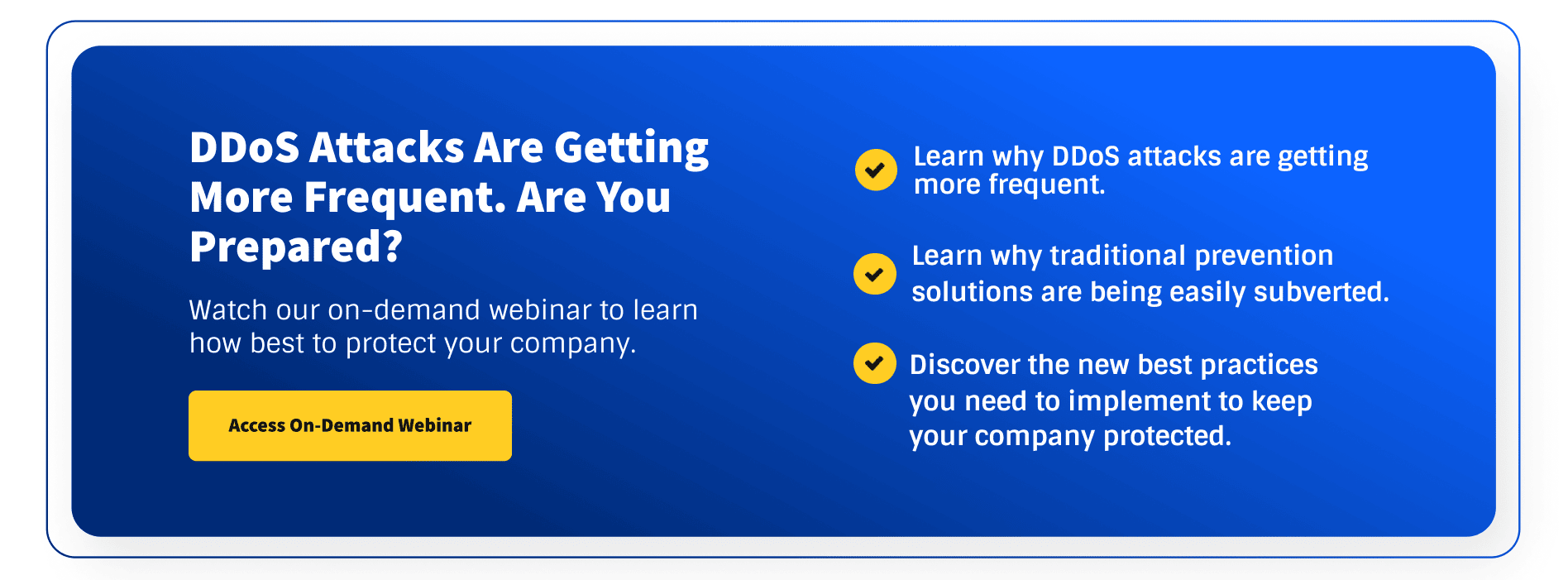How to Stop DDoS Attacks in 2022: 5 Critical Steps to Take to Keep Your Business Safe

A successful Distributed Denial of Service (DDoS) attack can cripple your business.
Your business can go from being online to locked out within minutes. Worse, it can take hours or even days to restore services. And the threat of DDoS attacks is steadily growing. In the first quarter of 2022, Kaspersky reported 91,052 DDoS attacks, an all-time high.
There are several options to consider to mitigate DDoS attacks. There are DIY methods, on-site appliances, and off-premise cloud-based solutions. Which one should you choose?
This blog post outlines the five critical steps to mitigate DDoS attacks and will help you decide what’s best for your business.
What is a DDoS Attack?
In simple terms, a DDoS attack is a cybercrime. The attacker floods your network with traffic using multiple distributed devices to stop real users from reaching and using the network.
DDoS attacks work by taking advantage of your bandwidth capacity. Your edge devices can handle a finite number of requests, and attacks aim to exceed that number to prevent your network from working correctly.
Why would someone want to stop your network from functioning? They might be hacktivists who want to make a statement. It could be extortion, where attackers ask for a ransom and demand large sums of money to reverse the damage.
Whatever the reason, you need to protect yourself against malicious DDoS attacks. The effects an attack has on your business are far-reaching. Your employees can’t do their jobs, you might suffer financial losses, and they damage your reputation.
A robust defense against DDoS attacks is paramount to mitigation. Reacting to an attack is the worst position to be in. Stopping an attack before it has a chance to do damage? Now we’re talking.
1. Offense is the Best Defense
DDoS attacks are becoming harder to detect. They’re more sophisticated, and attackers are combining them with other types of attacks, including ransomware. While AI and machine learning are advancements for good, they also provide attackers with the tools to conduct their attacks. Botnets, for example, roam networks looking for vulnerable systems. They also use AI to evolve and thwart detection by changing strategies.
As you can see, instead of desperately trying to detect attacks and react to them, prevention is the best course of action.
Start analyzing traffic patterns and look out for telltale signs of a DDoS attack:
- A sharp increase in traffic (this can be confused with a legitimate spike in traffic).
- A flood of traffic from a single IP address or range.
- Slow access to files.
- Problems accessing websites.
There are more signs to look out for, but these are common.
It’s crucial to use DDoS protection that’s "always on." Instead of reacting to a threat or attack, always-on deployment protects the service or network constantly. It’s much faster and more reliable, helping to maintain seamless operations.
2. Protect Your Network With Firewalls And Other Security Measures
There are many ways to protect against attacks on your servers and networks. Basic protections still have their place. You might use:
- A Virtual Private Network (VPN) to mask and encrypt your IP address so that hackers have trouble disrupting your Internet access.
- You might receive phishing scams in your email inbox; report them immediately.
- Keep your security systems and apps up to date.
- Install antivirus software to alert you of potential malware attacks.
- Use web application firewalls.
While it’s good practice to protect your servers and networks with the above, unfortunately, DDoS attackers can find their way around and through them. A firewall, for example, is like a hockey goalie with nobody in front of them. But the other teams’ players all have sticks and pucks and are constantly pinging the goalie.
You need a goalie, but you also need defensemen, wingers, and a center and help ensure the other team only has one puck.
Other security measures include:
- Creating customized mitigations against illegitimate requests disguised as good traffic.
- Studying traffic patterns and creating protections.
- Deploying DDoS protection appliances that sit in front of firewalls.
3. Scale Bandwidth and Server Capacity
Effective protection against DDoS attacks includes improving your network architecture, such as bandwidth and server capacity. Attacks exceeding the bandwidth of your DDoS prevention provider will hit your servers.
With more available bandwidth than you need, you can accommodate traffic spikes and buy yourself some time. It’s not the most cost-effective solution, but often, cloud-based solutions are more easily scalable to defend against high-volume attacks.
You can also build redundancy into your infrastructure by spreading your servers across multiple data centers.
4. Alert Your Internet Service Provider (ISP)
Your ISP needs to know that you’re under attack. Ask them for help. Unfortunately, you might not be their top priority, and ISPs generally offer only essential DDoS protection, but they should still protect against basic attacks.
They might have already detected an attack. If your web server is located in a hosting center, you have more chance of withstanding the attack (higher bandwidth and server capacity).
ISPs might need to “black hole” you to avoid disrupting other customers. This involves routing unwanted traffic into a black hole. However, it might also lead to network downtime and lost traffic.
Instead of relying on your ISP, whose main job is to provide a service, turn to a dedicated protection service like atlantech|ddos protect. With around-the-clock support and automatic protection, you can eliminate the cost of an attack and bypass your ISP.
5. Document Your Response to a DDoS Attack
You can take all the measures available, yet DDoS attackers might find their way through. When they do, it’s essential to document what happened adequately, how, and why. With forensic-level analysis before, during, and after attacks, you can build a resource that strengthens your prevention efforts.
Next, create a playbook that documents the steps to take in case of a DDoS attack. Identify those responsible for each part of the process response. Finally, how will you communicate the problem to your customers? A documented process makes communication simpler and helps protect your client relationships.
How to Stop DDoS Attacks in 2022: Prevent, Detect, and Mitigate
Prevention and mitigation are the best defense against DDoS attacks. You can’t always detect an attack, but with detailed reporting, increased bandwidth, and robust security measures, you can put your best foot forward and feel at ease knowing you’re protected.
With atlantech|ddos protect, you can feel confident that you’re in good hands. Among other benefits, Atlantech Online provides:
- Automatic and always-on protection that’s 20x faster than other solutions.
- Affordable protection with no hardware or installation costs.
- No staff is required - 98 percent of attacks are mitigated automatically.
- Live status and detailed attack reporting, so you’re always in the know.
Big Telecom and ISPs don’t care about you. They care about selling packages in bulk. You’re just a number to them. To them, a DDoS attack on your network is just “a risk of doing business.”
Instead, get a customized and scalable solution to protect against DDoS attacks, or watch our free webinar to find out the best practices for mitigating against DDoS attacks.


